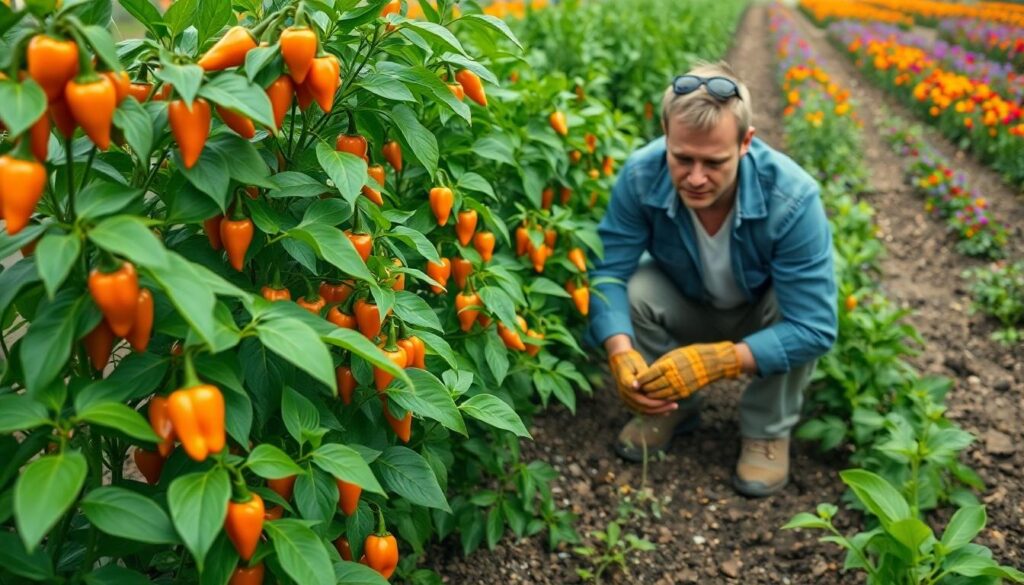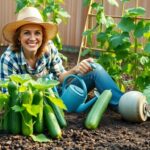Growing habanero peppers might seem intimidating, but we’ve discovered the secrets that can transform anyone into a successful hot pepper gardener. These fiery gems aren’t just culinary treasures—they’re surprisingly rewarding to grow with the right approach.
We’ll reveal the essential techniques that experienced growers don’t share easily. From selecting the perfect soil composition to understanding the crucial timing for watering, our tried-and-tested methods will help you cultivate thriving habanero plants that produce abundant, flavorful peppers. Whether you’re a novice gardener or a seasoned pro looking to boost your yield, these insider tips will revolutionize your habanero growing experience.
Choosing the Right Habanero Varieties for Your Climate
Selecting the appropriate habanero variety for your exact climate zone can make the difference between a mediocre harvest and an abundant one. Understanding which types thrive in your region will set you up for success from the very beginning.
Understanding Heat Levels and Flavor Profiles
Habanero peppers vary dramatically in their Scoville heat units (SHU), ranging from 100,000 to over 350,000 SHU. Caribbean Red habaneros typically register between 300,000-445,000 SHU, making them significantly hotter than the standard orange varieties that usually measure 100,000-350,000 SHU. Chocolate habaneros offer a unique sweet, smoky flavor profile with heat levels around 300,000-425,000 SHU. Red Savina habaneros, once holding the industry record for hottest pepper, deliver intense heat at 350,000-575,000 SHU alongside their fruity undertones. For those seeking milder options, habanada peppers provide all the tropical flavor of habaneros with virtually no heat, making them perfect for those who enjoy the taste but prefer to avoid the burn.
Best Varieties for Beginners
Orange habaneros stand as the ideal starter variety for novice growers due to their reliability and adaptability to various growing conditions. These classic peppers mature in 75-90 days and produce abundantly even with minimal experience. Red Caribbean habaneros offer another beginner-friendly option, maturing slightly faster than oranges while maintaining excellent disease resistance. Mustard habaneros prove particularly forgiving in inconsistent watering situations, making them perfect for busy gardeners. First-time growers should avoid the challenging Ghost pepper hybrids that require precise temperature control and extended growing seasons. Most beginners find success with container-grown habaneros, which allow for mobility during unexpected weather changes and provide better control over soil conditions.
Preparing the Perfect Soil Mix for Habanero Success
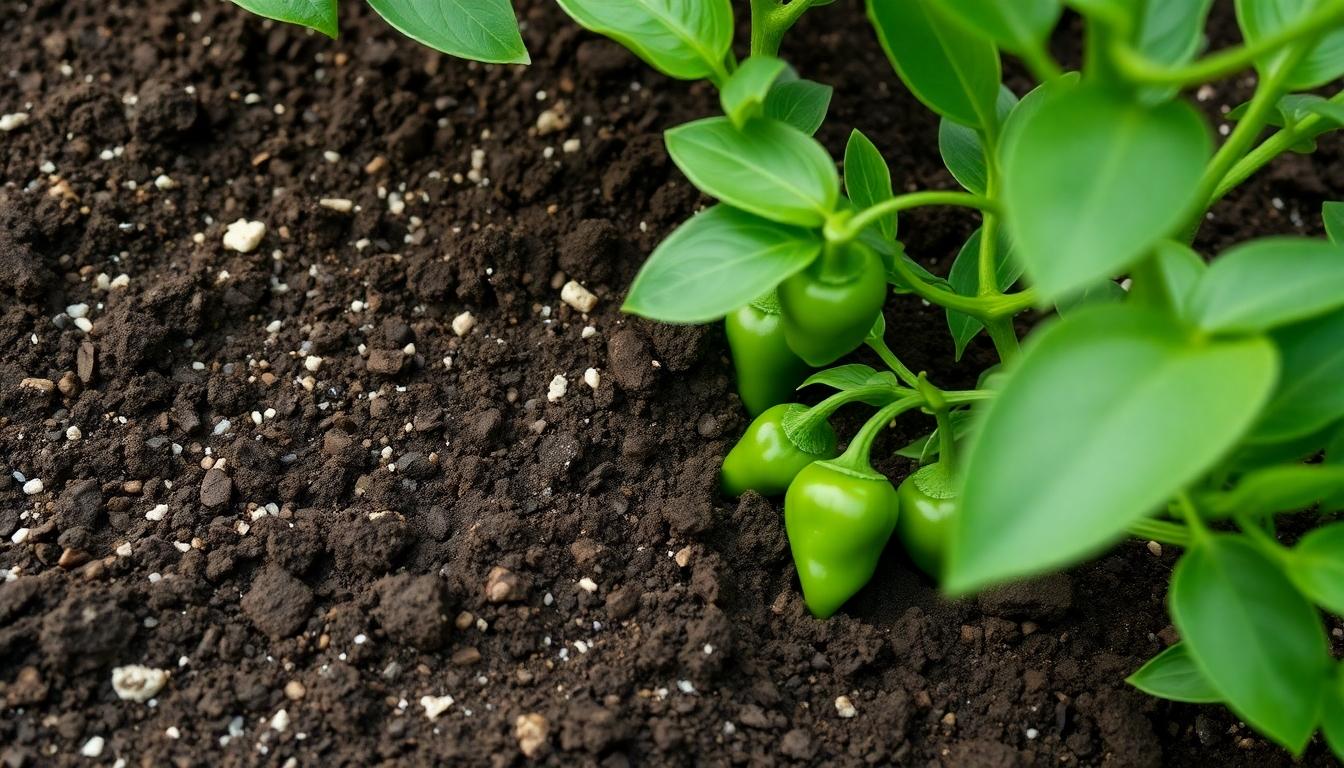
Creating the ideal foundation for your habanero plants begins with the perfect soil mix. We’ve found that habaneros thrive in well-draining soil that’s rich in plant nutrients. Incorporating perlite or vermiculite significantly enhances soil aeration and drainage, which prevents root rot and promotes healthier plants. Adding organic compost to your soil mixture provides essential nutrients that fuel robust growth and abundant pepper production.
The Ideal pH Balance for Maximum Yield
Maintaining the correct soil pH is crucial for successful habanero cultivation. Habanero peppers specifically require a soil pH between 6 and 6.8 to achieve maximum yields. This narrow pH range ensures optimal nutrient absorption and supports healthy fruit development. Testing your soil before planting allows you to make necessary adjustments with lime to increase pH or sulfur to decrease it if needed.
Essential Nutrients Your Habanero Plants Crave
Nitrogen serves as a fundamental nutrient for habanero growth, particularly during the mature growth stage. We recommend aiming for approximately 6% nitrogen concentration per plant, as excessive amounts can result in lush foliage but fewer peppers. Calcium plays a vital role in preventing blossom end rot, a common issue that affects many pepper varieties. Deep watering practices during the blooming period help maintain adequate calcium levels throughout the plant.
Balanced fertilizers provide necessary micronutrients that support overall plant health and productivity. Apply your chosen fertilizer as a side dressing approximately six weeks after planting to give your habaneros a boost during their critical development phase. Organic options like fish emulsion or compost tea work exceptionally well for feeding habanero plants without risking chemical burn.
Mastering the Art of Seed Starting and Germination
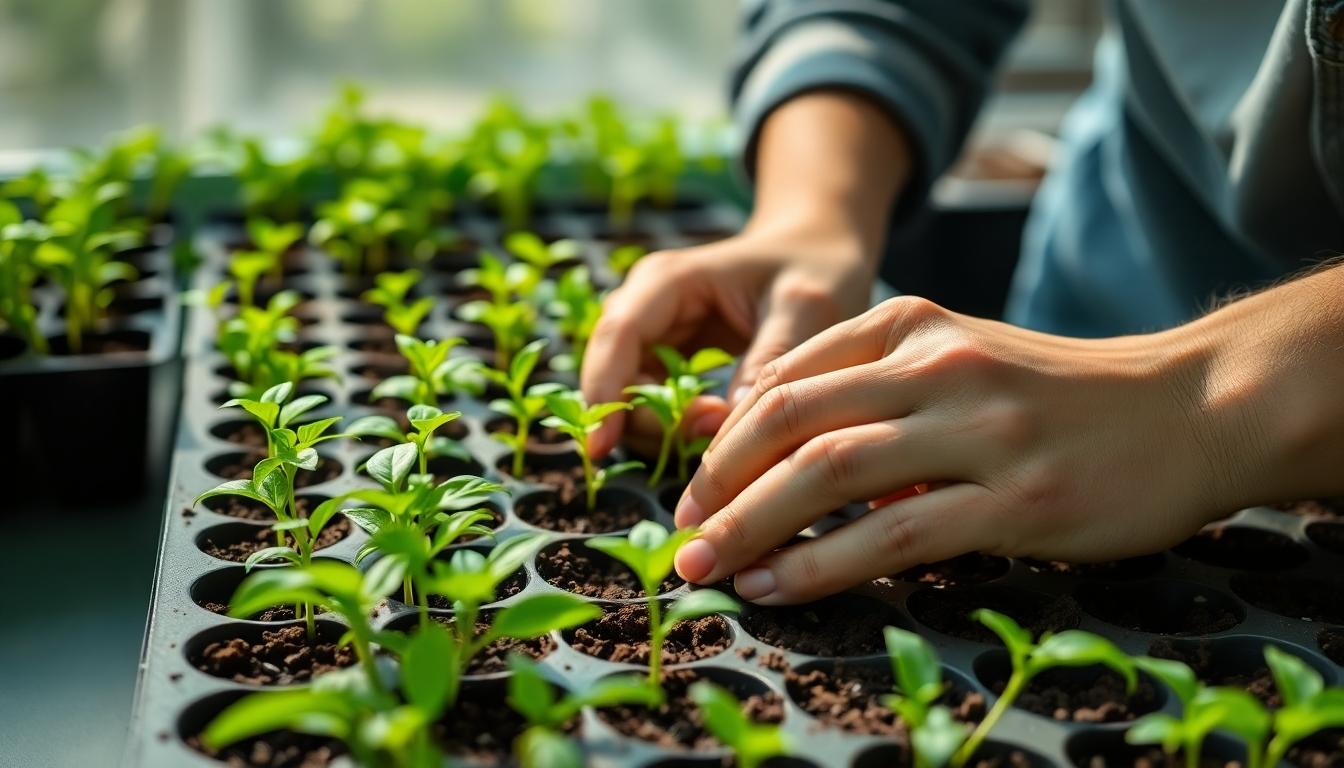
Starting habanero seeds properly sets the foundation for healthy, productive plants. We recommend beginning 8-10 weeks before your region’s last frost date to give your peppers ample time to establish before transplanting outdoors.
Temperature Controls for Optimal Germination
Habanero seeds require consistent soil temperatures between 80–90°F for fastest germination results. Under these ideal conditions, seeds typically sprout within 7–10 days, with some emerging as quickly as 4 days when all factors are optimized. Seedling heat mats prove invaluable for maintaining these temperatures, especially in cooler environments where ambient temperatures fluctuate. After germination occurs, reduce the temperature to 60–70°F indoors until outdoor nighttime temperatures consistently stay above 50°F. This temperature management approach creates the perfect environment for your seedlings to develop strong root systems and healthy foliage before facing outdoor conditions.
Pre-Sprouting Techniques for Higher Success Rates
Pre-soaking habanero seeds dramatically improves germination rates by jumpstarting the growing process. Immerse seeds in room-temperature water (68–70°F) for 24–48 hours to properly hydrate the embryos before planting. Plant pre-soaked seeds in seed trays or plugs with well-draining soil, placing 2-3 seeds per cell at a shallow depth of only 1/8-1/4 inch. Humidity domes create the perfect moisture-retention environment during this critical phase, while daily light misting prevents soil from drying out. Filtered light exposure during early germination stimulates growth, with a transition to bright indirect light once sprouts emerge. Thin seedlings after they develop their second set of true leaves, keeping only the strongest plant in each cell to maximize growing resources. Your seedlings will be ready for transplanting when they develop 6-8 true leaves, typically 6-8 weeks after germination.
Transplanting Secrets: When and How to Move Seedlings

Transplanting habanero seedlings is a critical step that can determine the success of your pepper harvest. We’ve discovered that timing and technique are everything when moving your young plants to their permanent homes.
Hardening Off Without Shocking Your Plants
Hardening off involves gradually acclimating your seedlings to outdoor conditions over a 7-10 day period. Start by placing your plants in indirect sunlight for just 1 hour on the first day, then incrementally increase exposure time each subsequent day. This gentle transition prevents leaf scorch, which commonly occurs when indoor-grown seedlings are suddenly exposed to direct sunlight. The process toughens your habanero plants by allowing them to adapt to outdoor temperature fluctuations and wind conditions. Remember to bring plants back indoors during this period if temperatures drop significantly or strong winds arise.
Proper Spacing for Healthy Growth
Habanero plants require at least 18 inches of space between each plant to thrive properly. Adequate spacing ensures sufficient airflow around your peppers, significantly reducing the risk of fungal diseases that thrive in humid, crowded conditions. Plants given proper room develop stronger root systems that efficiently access nutrients from the surrounding soil. Fertilize your established habaneros every 2 weeks using balanced formulas like fish emulsion or sulfur spray to maintain steady growth. When transplanting, enrich each planting hole with sand and composted cow manure to improve drainage and provide essential nutrients. Adding a few matches to the root zone supplies sulfur that deters fungal growth while boosting overall plant health. Always transplant on a cloudy day or in the evening to minimize transplant shock, and water deeply immediately after planting to help roots establish quickly.
Watering Wisdom: The Secret to Avoiding Common Mistakes
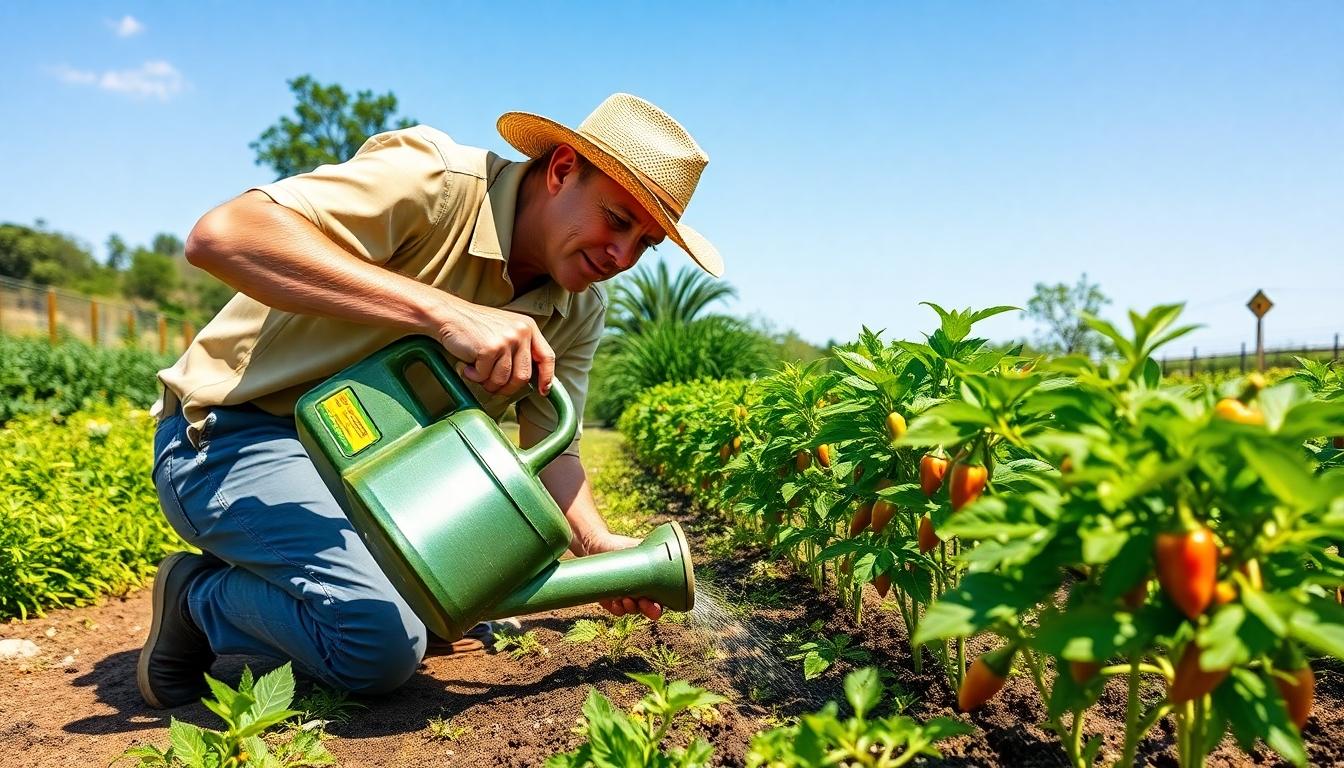
Developing a Consistent Watering Schedule
Establishing a reliable watering routine is fundamental to successful habanero cultivation. We’ve found that habaneros need more frequent watering during hot and dry conditions, sometimes requiring more than twice-weekly hydration to thrive. During cooler climate periods, limit watering to no more than twice a week to prevent oversaturation. The goal is maintaining soil that’s consistently damp but never waterlogged, striking that perfect moisture balance your plants crave.
Deep watering practices yield superior results compared to frequent shallow watering. Water thoroughly until you see drainage from the bottom of your containers or planting area, then allow the top 1-2 inches of soil to dry out before watering again. This approach encourages deeper root development, resulting in stronger, more resilient habanero plants that can better withstand occasional dry spells.
Signs of Overwatering and Underwatering
Recognizing water stress symptoms early can save your habanero crop from disaster. Overwatered plants typically display yellowing leaves that may feel soft and mushy when touched. Root rot often follows excessive moisture, characterized by an unpleasant smell and visible fungal growth near the plant base. Standing water around your habaneros serves as a clear warning sign that you’re providing too much hydration.
Underwatering manifests through distinct visual cues that shouldn’t be ignored. Wilting leaves, even with adequate sunlight, signal insufficient water reaching the plant cells. Drooping stems and dull, lackluster foliage indicate your habaneros are desperately seeking moisture. The soil will appear dry and may crack or pull away from the container edges. Prompt watering usually revives underwatered plants, though recovery becomes more difficult after prolonged drought stress.
Adjusting for Climate and Soil
Climate conditions dramatically influence your watering strategy and require thoughtful adaptation. In hot, arid environments, habanero plants might need watering every 2-3 days to compensate for rapid evaporation. Cooler, more humid climates allow for reduced watering frequency, typically once every 5-7 days depending on rainfall patterns. Monitoring weather forecasts helps anticipate when additional irrigation might become necessary.
Soil composition significantly impacts water retention and absorption rates. Sandy soils drain quickly and require more frequent watering schedules to maintain appropriate moisture levels. Clay-heavy soils retain water longer but risk becoming waterlogged without proper drainage amendments. Testing your exact soil type allows for customized watering adjustments that meet your habaneros’ precise needs while avoiding common moisture-related issues.
Early morning watering offers important benefits for habanero plants. This timing allows roots to absorb moisture before midday heat intensifies, reducing evaporation waste and preventing leaf scalding. Performing a simple soil moisture test by inserting your finger about an inch into the soil provides reliable feedback about when to water. The soil should feel slightly dry at this depth before the next watering session to prevent oversaturation while ensuring adequate hydration.
Container Growing vs. Garden Bed: Choosing Your Approach
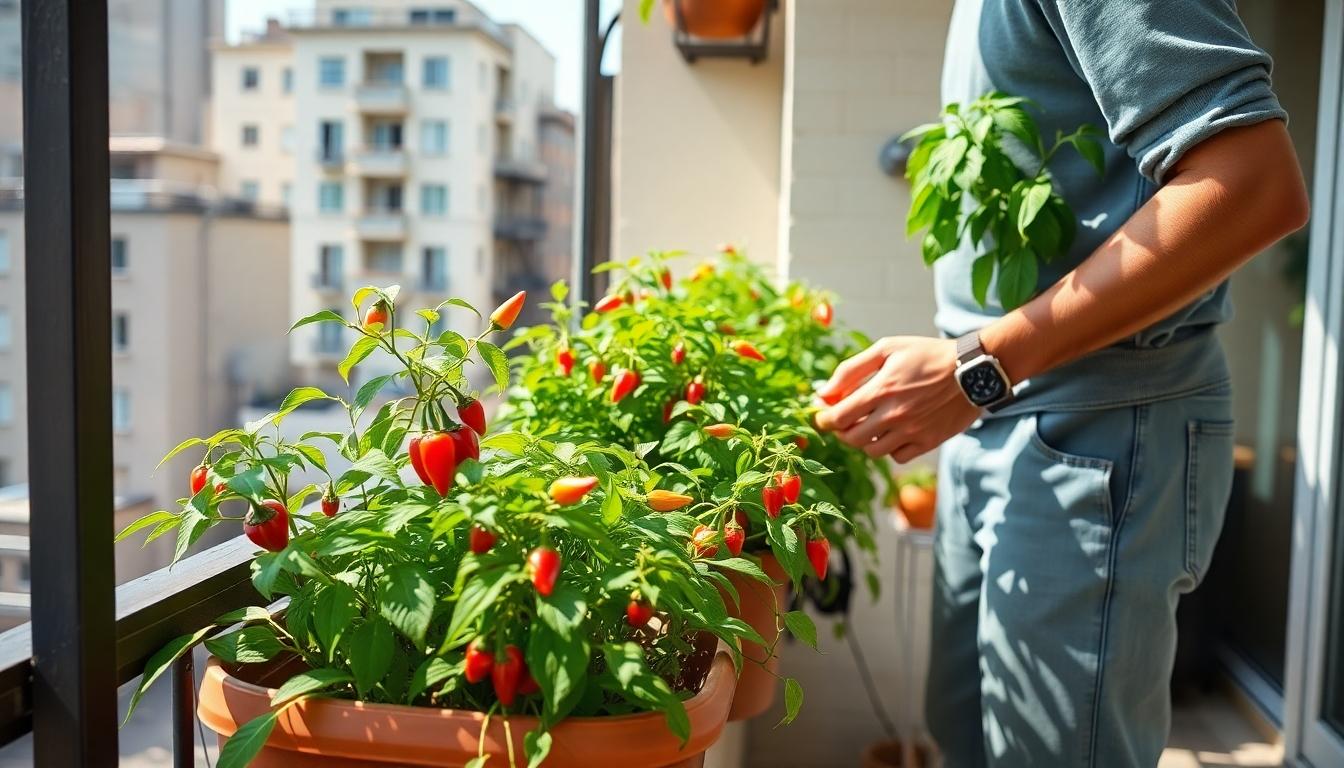
When deciding between container growing and garden bed cultivation for habaneros, your available space and ability to control growing conditions should guide your choice. Container growing offers flexibility for urban settings with limited space, while garden beds provide more natural growing environments for your pepper plants.
Space-Saving Answers for Urban Growers
Container growing stands out as the perfect solution for urban gardeners looking to maximize limited space while cultivating habanero peppers. This approach gives you enhanced control over your growing environment, making it easier to adjust conditions for optimal pepper production. Your habanero plants will thrive when provided with at least six hours of direct sunlight daily, which becomes simpler with movable containers that can follow the sun. Well-drained soil with the appropriate pH between 6 and 6.8 creates the foundation for healthy root development in container-grown habaneros. Maintaining consistent moisture without overwatering becomes more manageable in containers where you can precisely monitor soil conditions and adjust accordingly for your pepper plants.
Container Selection and Preparation
Choosing the right container dramatically impacts your habanero growing success, with size being the most critical factor to consider. Select containers that are at least 5 gallons (approximately 577 cubic inches or 9,455 cubic centimeters) to accommodate the extensive root system that habanero plants develop. Drainage holes are essential features of any container you choose, as they prevent waterlogged soil that can lead to root rot and other moisture-related issues. Fill your selected container with well-drained, slightly acidic soil that provides the perfect growing medium for these heat-loving peppers. Position your containers in locations receiving full sun exposure and maintain warm temperatures to create ideal growing conditions, as habaneros thrive in heat and bright light.
Temperature Management: The Hidden Key to Spicy Peppers
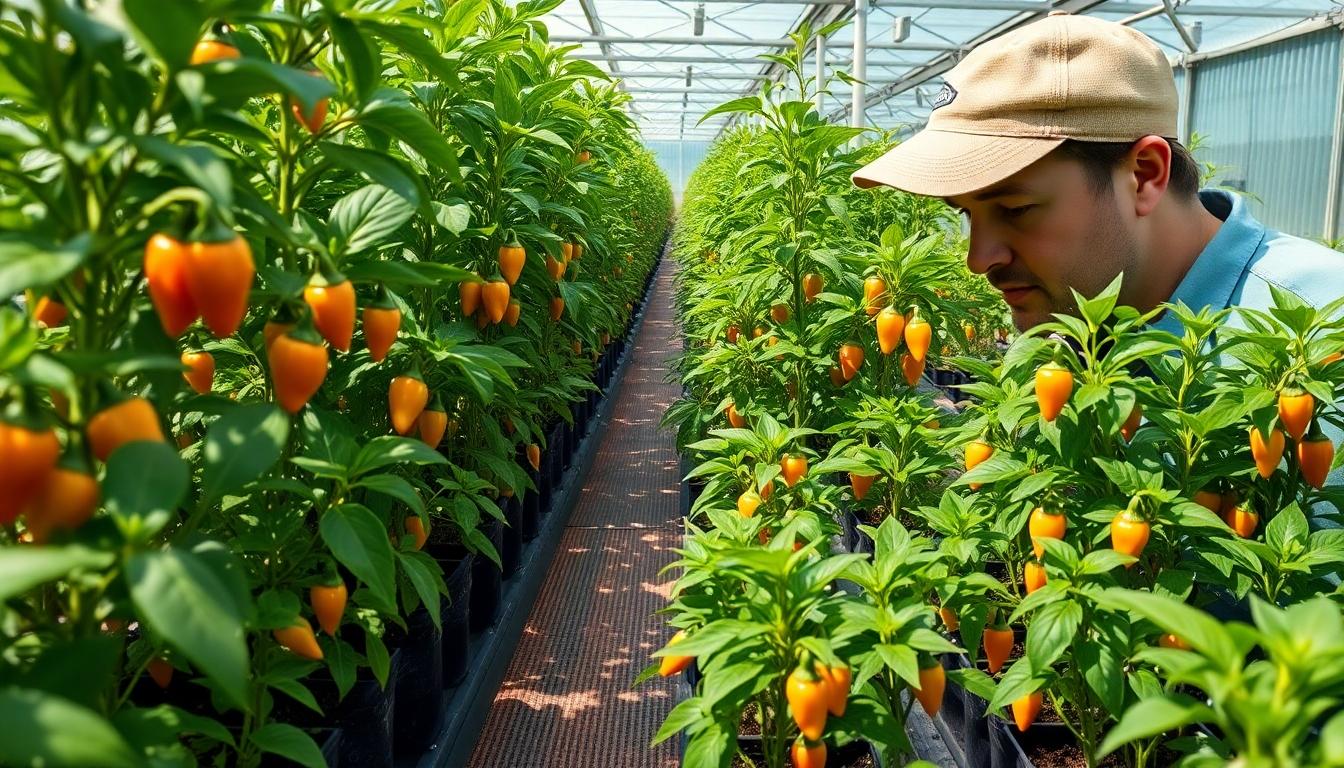
Managing temperature effectively is what separates successful habanero growers from the rest. Habaneros thrive in exact temperature conditions that must be maintained for optimal growth and maximum heat development.
Optimal Temperature Requirements for Habaneros
Habanero peppers demand warm conditions to reach their full potential. These spicy fruits flourish best when temperatures stay between 75°F and 95°F (24°C to 35°C). Germination occurs most efficiently at 75-85°F (23-29°C), triggering robust seedling development. Plants maintained within these ideal temperature ranges produce more abundant yields and develop higher capsaicin levels, resulting in those signature fiery peppers we crave. Maintaining consistent temperatures throughout the growing season gives your habaneros the steady environment they need to focus energy on fruit production rather than adapting to fluctuating conditions.
Heat-Boosting Techniques for Maximum Capsaicin
Heat mats offer an excellent solution for maintaining ideal temperatures during germination and early growth stages. Placing seedling trays on specialized heating equipment helps maintain the critical 75-85°F range that maximizes germination rates. Local heating systems in greenhouses or growing areas create microenvironments that keep plants within their optimal temperature zone even when ambient temperatures fluctuate. Strategic placement near heat-reflecting surfaces, such as south-facing walls, allows plants to benefit from additional warmth throughout the day. Growing habaneros in dark-colored containers can also boost soil temperature by absorbing more solar radiation than lighter containers.
Protecting Plants During Temperature Extremes
Frost protection becomes essential in cooler climates or during unexpected temperature drops. We recommend waiting until all danger of frost has passed before transplanting habaneros outdoors, typically when nighttime temperatures consistently remain above 55°F. Cloches and row covers provide excellent protection during cooler periods, creating a warmer microclimate around developing plants. Extreme heat requires vigilant monitoring, as temperatures exceeding 95°F can stress plants and reduce fruit production. Good ventilation in greenhouses prevents heat buildup that can damage plants, while shade cloth offers protection during the hottest parts of the day. Water management becomes particularly critical during temperature extremes—plants need more moisture during heat waves but require careful watering during cooler periods to prevent root diseases.
Feeding Strategies That Maximize Fruit Production
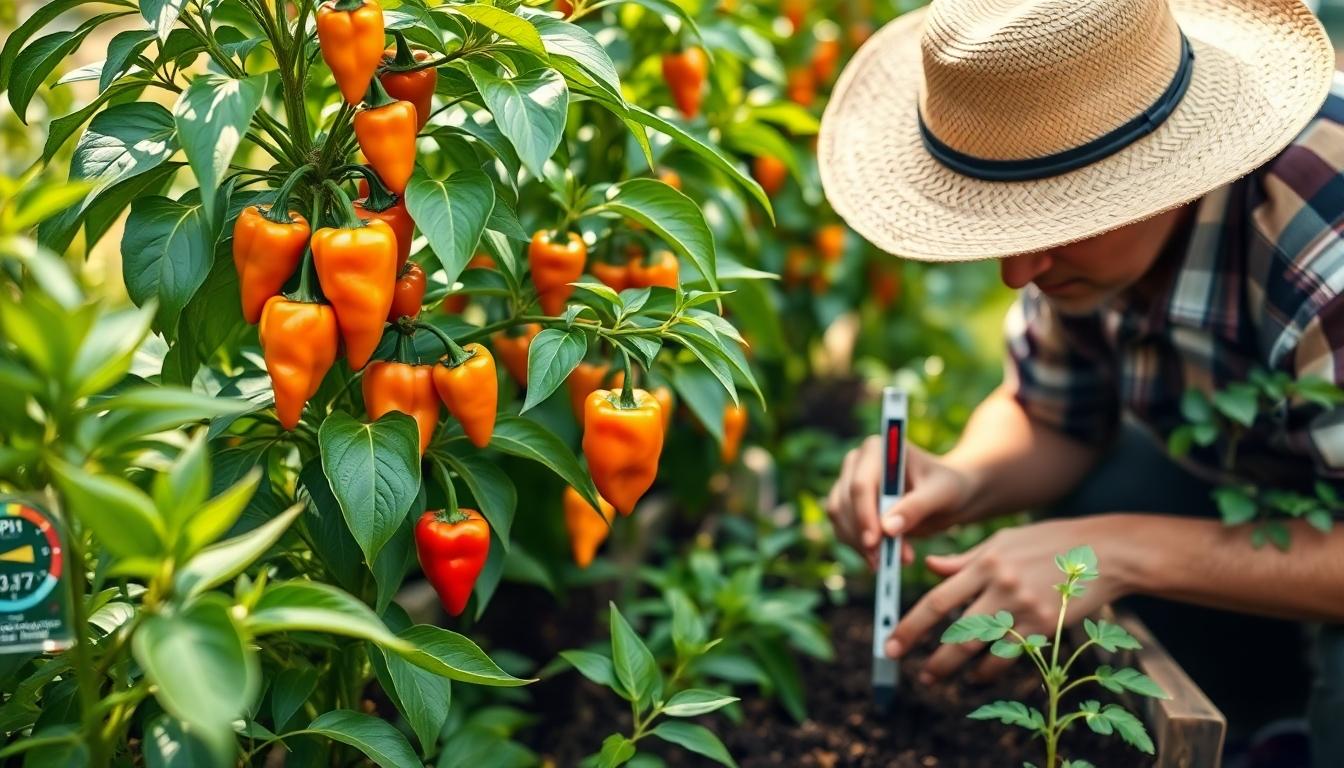
Proper fertilization is the secret weapon for achieving abundant habanero harvests. We’ve discovered that a strategic, phased approach to feeding these peppers can dramatically increase your fruit production.
Timing Your Fertilizer Applications
Timing your fertilizer applications correctly is crucial for maximizing habanero fruit production. Begin your feeding schedule approximately 14 days after transplanting seedlings to their permanent location. Applications should then follow a consistent cycle, repeating every 4-6 weeks throughout the growing season. When your plants start flowering (typically 4-6 weeks after planting), it’s time to switch to a high-phosphorus and potassium fertilizer to support fruit development. Maintain this feeding schedule until the fruiting cycle ends. We recommend avoiding late-season fertilization, as this allows plants to focus their energy on ripening existing fruit rather than producing new foliage.
Organic vs. Synthetic: What Works Best for Habaneros
Choosing between organic and synthetic fertilizers depends on your gardening philosophy and your plants’ immediate needs. Organic options like fish emulsion and compost tea release nutrients slowly, improving overall soil health and structure. These natural fertilizers require earlier application due to their gradual nutrient release but reduce the risk of burning your plants. Synthetic fertilizers, such as water-soluble 10-10-10 formulations, deliver precise nutrient ratios for immediate plant uptake, making them ideal for correcting deficiencies quickly. But, these can cause salt buildup and root damage if overapplied.
For habaneros specifically, we recommend starting with a balanced fertilizer (10-10-10) or fish emulsion during the early growth stage. Once flowering begins, transition to a fertilizer with higher phosphorus and potassium ratios (such as 5-10-10 or 2-3-1) while reducing nitrogen to prevent excessive foliage growth at the expense of fruit production. Calcium and magnesium supplements are essential additions to prevent blossom-end rot and strengthen plant cell walls for healthier peppers. Always test your soil before planting to maintain the optimal pH range of 6.0-6.8, ensuring your habaneros can efficiently absorb the nutrients you provide.
Pruning and Training for Abundant Harvests
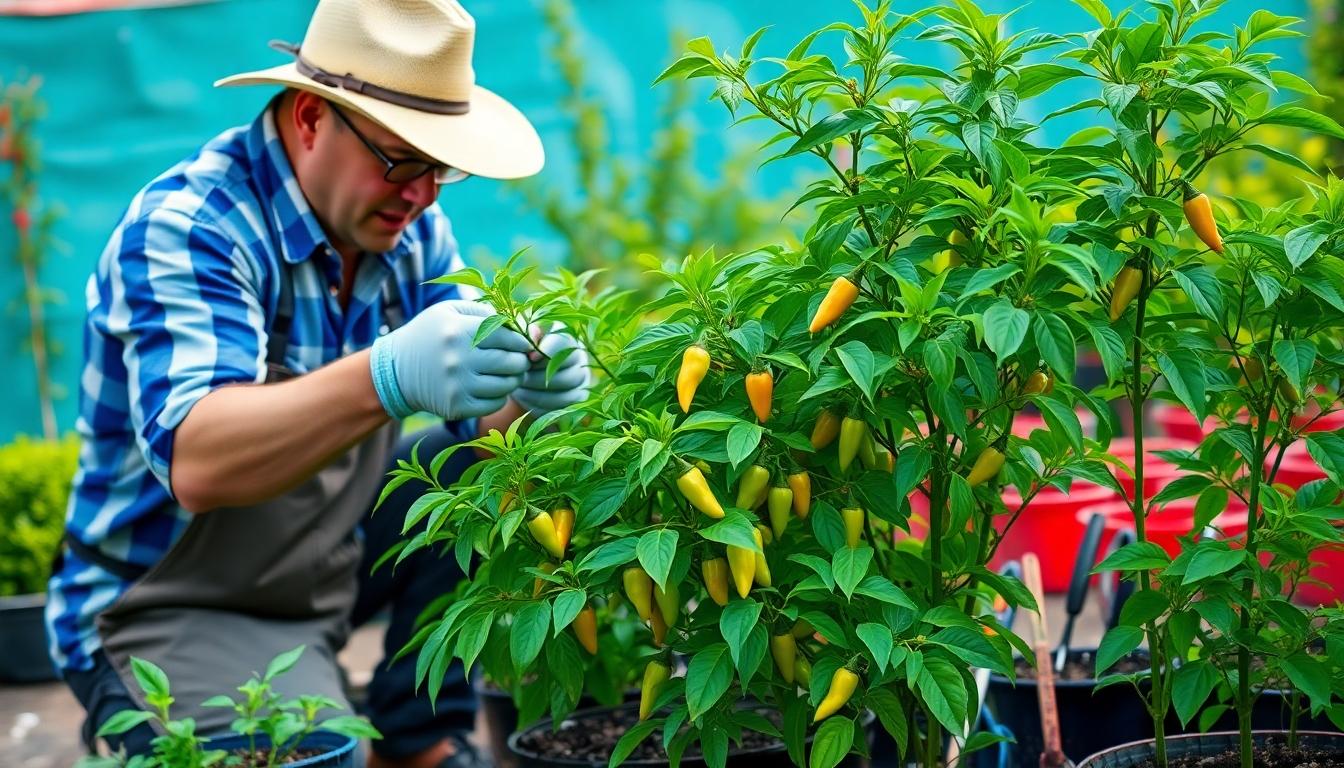
Proper pruning and training techniques can transform your habanero plants from ordinary to extraordinary, significantly boosting your harvest potential. Strategic pruning redirects the plant’s energy to fruit production rather than excessive foliage, resulting in more peppers and healthier plants.
When to Top Your Plants for Bushier Growth
Topping your habanero plants immediately after transplanting is the perfect timing for encouraging bushier growth. We recommend using sanitized shears to make a clean cut just above a leaf node, which activates dormant buds and promotes lateral branching. This early pruning technique redirects energy to side branches, creating a sturdier plant structure capable of supporting more fruit. Most compact habanero varieties benefit greatly from topping, unlike larger pepper varieties that may not require this treatment. Your pruning schedule should include revisiting plants every 2-3 weeks during active growth periods to maintain their optimal shape. Remember to pinch off early flowers during the establishment phase to prioritize root development, which will pay dividends later with improved fruit production.
Support Systems for Heavy-Fruiting Plants
Stakes or cages provide essential support for habanero plants once they begin producing their characteristically dense fruit clusters. Without proper support, stems risk breaking under the weight of a bountiful harvest, particularly after your mid-season pruning efforts. Spacing plants 12-18 inches apart ensures adequate airflow and prevents overcrowding, which can lead to disease issues and competition for nutrients. Container-grown habaneros require special consideration – select dwarf cages that fit appropriately within your growing space and use pots at least 5 gallons in size to accommodate the extensive root system. Regular mid-season pruning, focusing on removing lower leaves and inward-facing branches, serves a dual purpose of reducing overall plant weight and improving stability. This strategic pruning also enhances air circulation, reducing fungal disease risk while directing the plant’s energy toward fruit production rather than unnecessary foliage.
Natural Pest Management for Habanero Plants
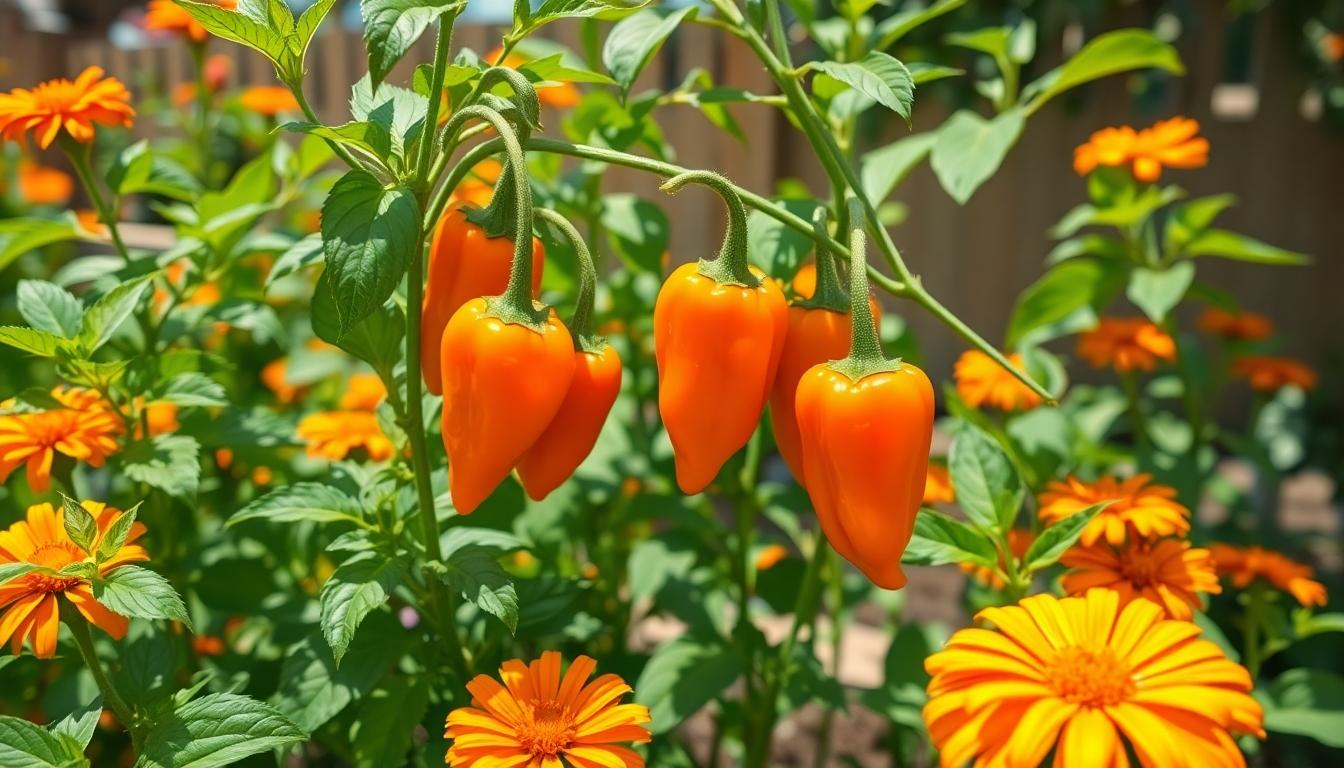
Protecting your habanero plants from pests doesn’t require harsh chemicals. With these natural management strategies, you’ll keep your pepper plants healthy while maintaining an environmentally friendly garden.
Identifying Common Habanero Predators
Habanero plants attract several persistent pests that can damage your harvest if left unchecked. Aphids frequently cluster on the undersides of leaves, sucking vital nutrients and causing leaves to curl or yellow. Whiteflies pose another important threat, appearing as tiny white insects that fly up when disturbed and can quickly reproduce to dangerous levels. Spider mites create fine webbing between leaves and stems, eventually causing spotting and leaf drop as they feed on plant cells. Thrips scrape plant surfaces to feed, leaving behind silvery patches and distorted growth on your habanero plants. Armyworms can be particularly destructive, chewing through foliage and even boring into developing peppers. Understanding these common predators helps us identify problems early and carry out targeted natural answers before infestations become severe.
Companion Planting for Pest Prevention
Strategic companion planting creates a natural defense system for your habanero peppers without chemical interventions. Basil and chives work wonderfully when planted alongside habaneros, naturally repelling aphids and other problematic insects through their aromatic compounds. Marigolds and nasturtiums serve as excellent protective companions, deterring nematodes and various pests while adding vibrant color to your pepper garden. Plant rotation plays a crucial role in long-term pest management; we recommend rotating habanero plants with non-solanaceous crops like legumes or leafy greens to disrupt pest life cycles and prevent soil nutrient depletion. Implementing these companion planting strategies reduces the need for intervention while creating a balanced garden network that naturally keeps pest populations in check.
Pest Control Methods
Soapy water answers provide a simple yet effective weapon against many common habanero pests. Mix two tablespoons of mild dish soap with a gallon of water to create a spray that targets soft-bodied insects like aphids, whiteflies, and spider mites without harming your plants. Apply this mixture every four to seven days until you notice the infestation subsiding, focusing on the undersides of leaves where pests often hide. Natural predators can become your allies in pest management; ladybugs, lacewings, and parasitic wasps eagerly consume many problematic insects that attack habanero plants. Beneficial microorganisms offer another layer of protection; products containing Beauveria bassiana (a naturally occurring fungus) effectively control pests like armyworms when applied according to package directions. Beneficial nematodes can also be introduced to the soil to target underground pests, though we recommend applying these treatments separately with a few weeks between applications for maximum effectiveness.
Harvesting Techniques to Encourage More Production

Regular harvesting is the secret weapon for maximizing your habanero yield. Strategic picking not only rewards you with flavorful peppers but actually stimulates the plant to produce more fruit throughout the growing season.
Knowing the Perfect Time to Pick
Habaneros reach their peak heat and flavor profile when fully mature, typically 90-100 days after transplanting. We recommend waiting until your peppers display a firm, glossy appearance with uniform coloration throughout the fruit. Most varieties undergo a dramatic color transformation, changing from green to vibrant orange, red, or yellow when ready for harvest. Timing your harvest correctly ensures optimal capsaicin levels for that signature habanero heat. Pick your peppers before the first frost arrives, as cold temperatures can quickly damage the fruit and compromise both flavor and texture.
Handling Hot Peppers Safely
Always wear protective gloves when harvesting habaneros to prevent painful skin irritation from capsaicin oils. We strongly advise against touching your face or eyes during or after handling these hot peppers, as this can cause intense burning sensations. Use sharp scissors or garden shears rather than pulling peppers by hand to avoid damaging the delicate stems and branches of your plants. After harvesting, wash your hands thoroughly with soap and cold water—never hot water, which opens your pores and increases capsaicin absorption. Store freshly harvested habaneros in breathable containers at temperatures between 55-60°F for optimal short-term preservation of flavor and texture.
Extending Your Growing Season: Secrets from Expert Growers
Expert habanero growers know that maximizing your harvest often comes down to extending the growing season as much as possible. By implementing specialized techniques, you’ll transform your short growing window into a lengthy, productive season.
Indoor Seed Starting for Early Success
Starting your habanero seeds indoors 6-10 weeks before the last frost gives your plants a important head start. Begin with well-drained soil with a pH between 6-6.8 to create the optimal foundation for germination. Seedlings should remain indoors for 8-10 weeks before moving outdoors, developing strong root systems and healthy foliage during this period.
For best results, transplant your seedlings at night to minimize transplant shock. This timing allows plants to establish themselves before facing the stress of direct sunlight. Black plastic mulch around your newly transplanted seedlings helps retain soil warmth and moisture while simultaneously suppressing weed growth that would compete with your developing plants.
Creating Microclimates in Your Garden
Strategic microclimate creation can dramatically improve your habanero growing success. Row covers provide essential protection against both sunscald and dehydration, creating a more stable environment for your heat-loving peppers. These protective barriers maintain humidity levels while still allowing sufficient airflow to prevent disease.
Sunlight exposure requires careful management when establishing habanero plants. Gradually introduce seedlings to direct sunlight, starting with just one hour daily and slowly increasing exposure time. This hardening-off process prevents shock and leaf burn that can severely set back growth.
During periods of extreme heat, providing afternoon shade becomes crucial for maintaining plant health. Temporary shade structures or strategically placed taller companion plants can create the dappled light conditions that protect habaneros from stress while still providing sufficient light for growth and fruit development.
Overwintering Techniques for Multi-Year Harvests
Transforming your habanero plants into perennials through overwintering can significantly increase your long-term yield. Before the first frost threatens, prune your potted habanero plants and relocate them indoors to protect them from freezing temperatures. This preparation allows the same plants to produce for multiple seasons rather than starting from seed annually.
Indoor habaneros require 6-8 hours of indirect sunlight daily to maintain health during winter months. Reduce watering frequency significantly during this dormant period to prevent root rot and other moisture-related issues. Plants need just enough water to sustain their minimal winter growth.
Pest management becomes particularly important for overwintered plants. Monitor regularly for common indoor pests like aphids, which can quickly colonize plants in controlled environments. Apply insecticidal soap at the first sign of infestation to protect your overwintering investment and ensure healthy plants for spring.
Critical Care Practices for Season Extension
Deep, infrequent watering prevents blossom end rot in habanero peppers, a condition directly linked to calcium deficiency. This watering strategy encourages deeper root development while maintaining consistent moisture levels that support proper nutrient uptake.
Apply balanced fertilizer every two weeks throughout the growth cycle to maintain plant vigor during your extended season. This regular feeding schedule ensures plants have the nutritional resources needed for continuous production, even beyond their typical growing window.
Avoid overhead watering whenever possible to reduce fungal disease risks that can cut your growing season short. Direct water application to the soil rather than foliage creates drier surface conditions that discourage pathogen development while still providing necessary hydration to roots.
Conclusion: Putting It All Together for Habanero Success
Growing habaneros isn’t just about following rules—it’s about developing a relationship with these fiery plants. By selecting the right variety, preparing nutrient-rich soil and maintaining ideal temperatures you’ll set yourself up for success.
Remember that patience pays off with habaneros. From germination to harvest can take months but the journey is worth it when you’re enjoying those intensely flavorful peppers from your own garden.
Whether you’re starting your first pepper plant or expanding your cultivation techniques with overwintering and microclimate strategies the key is consistency. With proper care your habanero plants will reward you with abundant harvests of these prized peppers season after season.
Happy growing!
Frequently Asked Questions
When is the best time to start habanero seeds indoors?
Start habanero seeds indoors 8-10 weeks before your region’s last expected frost date. This timing gives seedlings enough time to develop before transplanting outdoors. Use a seed-starting mix and maintain soil temperatures between 80-85°F (26-29°C) for optimal germination, which typically occurs within 7-14 days.
How much spacing do habanero plants need?
Space habanero plants 18-24 inches (45-60 cm) apart in rows that are 24-36 inches (60-90 cm) apart. This spacing allows adequate airflow between plants, reducing disease risk and giving each plant enough room to develop its root system and foliage without competition for nutrients and sunlight.
What size container is best for growing habaneros?
Choose containers at least 3-5 gallons (11-19 liters) in capacity for each habanero plant. Larger containers provide more soil volume, better temperature stability, and improved moisture retention. Ensure the container has adequate drainage holes to prevent waterlogging and root rot.
How often should I water habanero plants?
Water habanero plants when the top inch of soil feels dry to the touch, typically every 2-3 days in hot weather and less frequently in cooler conditions. Deep, infrequent watering is better than frequent shallow watering, as it encourages deeper root development and improves drought tolerance.
What temperature range do habanero peppers prefer?
Habanero peppers thrive in daytime temperatures between 75-90°F (24-32°C) and nighttime temperatures above 60°F (15°C). They can tolerate higher temperatures but may drop flowers when temperatures exceed 95°F (35°C). Growth slows significantly below 55°F (13°C), and plants can be damaged by frost.
When and how should I fertilize habanero plants?
Begin fertilizing habanero plants 2-3 weeks after transplanting with a balanced fertilizer (10-10-10). Once flowering begins, switch to a lower-nitrogen, higher-phosphorus and potassium formula (5-10-10) to promote fruit development. Apply fertilizer every 3-4 weeks throughout the growing season, following package instructions for application rates.
How do I harden off habanero seedlings before transplanting?
Harden off seedlings by gradually introducing them to outdoor conditions over 7-10 days. Start with 1-2 hours of filtered sunlight, increasing exposure daily while protecting from wind. Bring plants indoors at night initially, then leave them out overnight when temperatures remain above 55°F (13°C).
What are signs of over or under-watering habanero plants?
Underwatered plants show wilting leaves that don’t recover in the evening, dry soil, and leaf curling. Overwatered plants display yellowing leaves, stunted growth, wilting despite moist soil, and may develop root rot with a foul smell. Adjust watering frequency based on these signs and current weather conditions.
How do I know when habanero peppers are ready to harvest?
Habanero peppers are ready to harvest when they’ve reached their full size and changed from green to their mature color (orange, red, chocolate, or white depending on variety). This typically occurs 80-100 days after transplanting. The skin should be smooth and slightly waxy. Regular harvesting encourages more fruit production.
Can I overwinter my habanero plants?
Yes, habanero plants can be overwintered indoors. Before the first frost, prune the plant back by about one-third, check for pests, and transplant into a container with fresh potting soil. Place in a sunny window or under grow lights, reduce watering, and maintain temperatures above 55°F (13°C). Resume normal care in spring.

